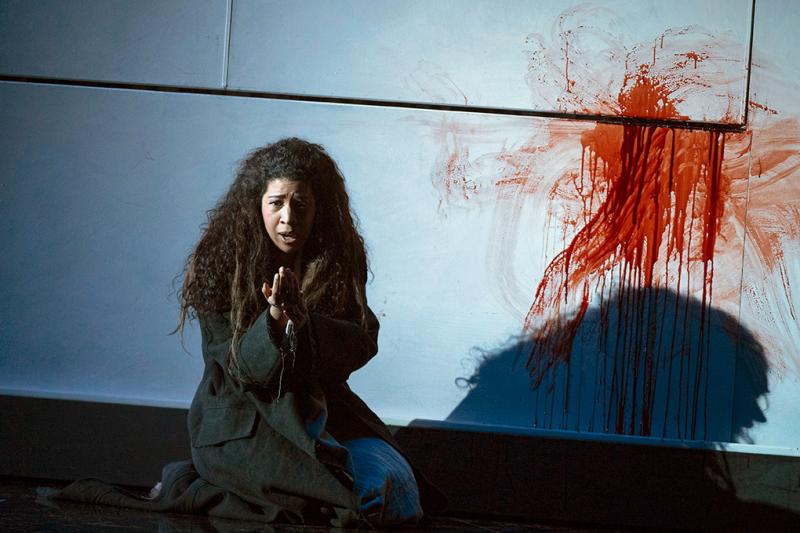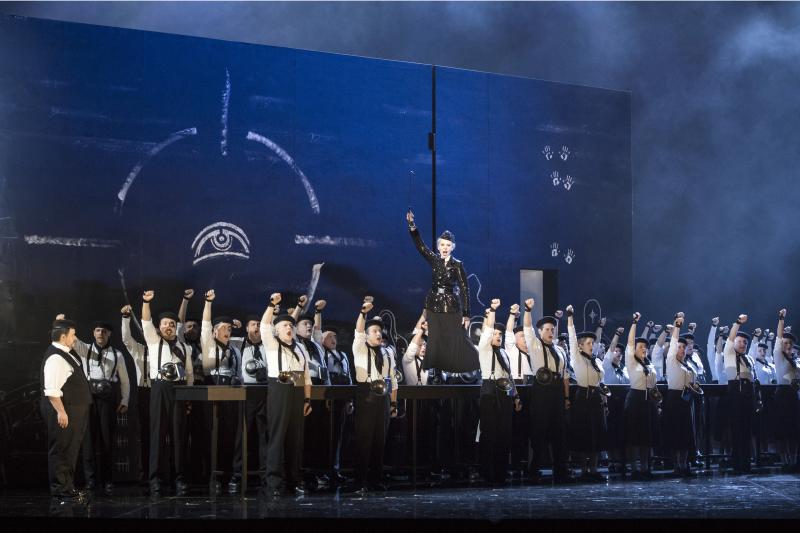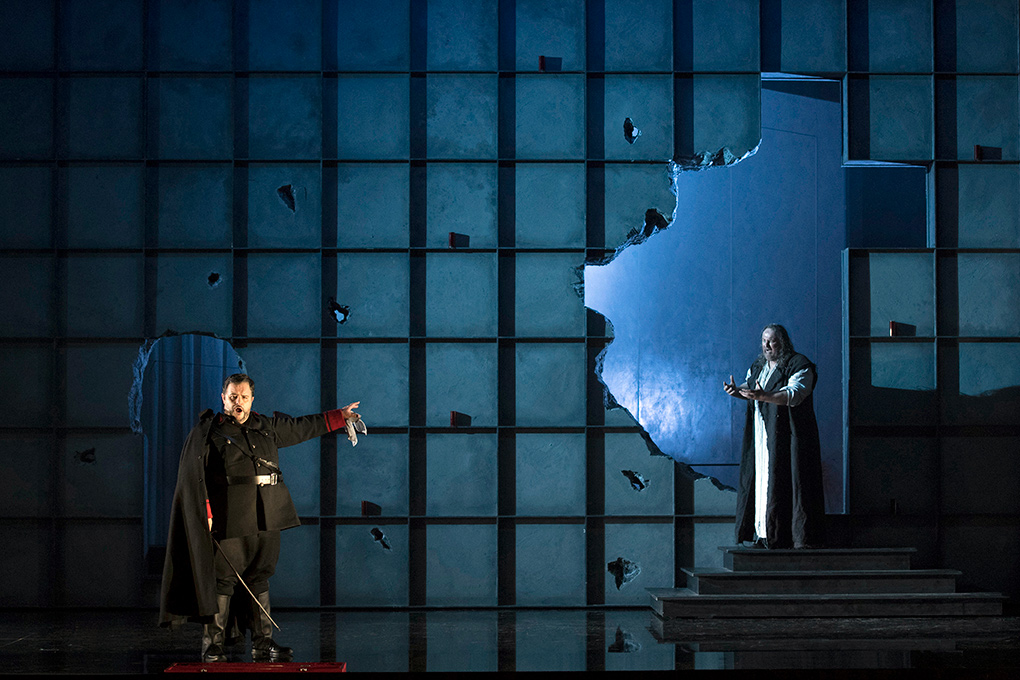La forza del destino, Welsh National Opera review - rambling drama, fine music | reviews, news & interviews
La forza del destino, Welsh National Opera review - rambling drama, fine music
La forza del destino, Welsh National Opera review - rambling drama, fine music
Verdi's Russo-Spanish hotchpotch given the full treatment with mixed success

David Pountney’s tenure at WNO has been an almost unqualified success, despite some eccentricities of repertoire and a certain obstinacy in the matter of new commissions. His own productions have included at least three of unforgettable quality.
Did Verdi have in mind some vague idea of what would go down well in barbaric Russia? It’s often been suggested that the work’s Petersburg premiere in November 1862 helped spark off the Russian love affair with wide-screen operas that mixed massive crowd scenes with intimate personal drama. But there was nothing very new about that idea, and in any case it’s hard to see what the Musorgsky of Boris Godunov could have got from a work that so signally fails to integrate its highly contrived revenge drama with a string of colourful but essentially aimless choruses of peasants, friars, soldiers and assorted vagrants, fronted by Preziosilla – surely the most vacuous of stage gypsies – and the deeply unfunny crosspatch friar Melitone.  So: Forza is a blind spot of mine. Too bad. Pountney does his best to fit these bits and pieces together. His Spain is, more or less, that of the civil war. He cleverly turns Preziosilla (the leggy, spry-voiced Justina Gringytė, pictured above with the WNO Chorus) into Destiny itself, forever wandering on in flowing black or sequins and a top hat (designer Marie-Jeanne Lecca), bashing the floor in time with Verdi’s stentorian opening, or handing out weapons to the duelling heroes.
So: Forza is a blind spot of mine. Too bad. Pountney does his best to fit these bits and pieces together. His Spain is, more or less, that of the civil war. He cleverly turns Preziosilla (the leggy, spry-voiced Justina Gringytė, pictured above with the WNO Chorus) into Destiny itself, forever wandering on in flowing black or sequins and a top hat (designer Marie-Jeanne Lecca), bashing the floor in time with Verdi’s stentorian opening, or handing out weapons to the duelling heroes.
He turns the Act II villagers into, presumably, fascist workers and kits out the anti-hero Don Carlo, supposedly disguised as a student, in something similar. He manages swift scene changes, with the help of Raymond Bauer’s highly efficient, if blockish and not very elegant or atmospheric abstract rolling-screen sets; and he hints at connections between the idiotic Hispanic revenge, that overrides all other duties of love, gratitude, intelligence and common humanity, and Spanish attitudes to the Church (the friars ridiculed as a chorus of mitred, bloodstained bishops), and to blood in general – the sort that flows down the generations, as well as the sort that flows when you bleed.
But if Forza is a trial dramatically (and it certainly rambles on, even in this discreetly trimmed performance of the revised score), it does have many a fine page of middle-period Verdi – not just the famous overture – and some of his most brilliant scoring, notably for brass and woodwind. The clarinet obbligato to Alvaro’s Act III aria is exquisite, and exquisitely played. The range of orchestral colour generally matches the kaleidoscopic dramaturgy, and is a good deal better organised. And if the individual characterisation is generally wooden, the vocal writing is often memorable.  One problem for the top castings, though, is the erratic rhythm of their appearances. Mary Elizabeth Williams captures beautifully and with vibrant tone Leonora’s emotional indecisiveness that is the trigger for the whole ludicrous farrago. But once safely ensconced in her mountain hermitage she vanishes from the stage for what seems like the eternity she craves, while her frustrated co-eloper, Gwyn Hughes Jones (the supposed Inca prince Alvaro), retires to the dressing room for the next hour or so.
One problem for the top castings, though, is the erratic rhythm of their appearances. Mary Elizabeth Williams captures beautifully and with vibrant tone Leonora’s emotional indecisiveness that is the trigger for the whole ludicrous farrago. But once safely ensconced in her mountain hermitage she vanishes from the stage for what seems like the eternity she craves, while her frustrated co-eloper, Gwyn Hughes Jones (the supposed Inca prince Alvaro), retires to the dressing room for the next hour or so.
Hughes Jones, no Laurence Olivier on stage, is a fine, stylish Italianate tenor, if inclined to flatten when lying wounded on a hospital bed, as no doubt one would. Luis Cansino(pictured above with Hughes Jones), as the vendetta-crazed Don Carlo, is a lovely dark baritone, if not exactly athletic of physique. Donald Maxwell, seventy this year and still going strong, does what he can with the lamentable Melitone. Miklós Sebestyén provides a good cameo of the Commendatore-like Calatrava, Leonora’s father, shot dead by a one-in-a-million stray bullet and not even allowed to come back as a statue.
And as usual there is the marvellous orchestra under Carlo Rizzi, to relish as one struggles with the mindless confusion beyond the proscenium.
Add comment
The future of Arts Journalism
You can stop theartsdesk.com closing!
We urgently need financing to survive. Our fundraising drive has thus far raised £49,000 but we need to reach £100,000 or we will be forced to close. Please contribute here: https://gofund.me/c3f6033d
And if you can forward this information to anyone who might assist, we’d be grateful.

Subscribe to theartsdesk.com
Thank you for continuing to read our work on theartsdesk.com. For unlimited access to every article in its entirety, including our archive of more than 15,000 pieces, we're asking for £5 per month or £40 per year. We feel it's a very good deal, and hope you do too.
To take a subscription now simply click here.
And if you're looking for that extra gift for a friend or family member, why not treat them to a theartsdesk.com gift subscription?
more Opera
 La bohème, Opera North review - still young at 32
Love and separation, ecstasy and heartbreak, in masterfully updated Puccini
La bohème, Opera North review - still young at 32
Love and separation, ecstasy and heartbreak, in masterfully updated Puccini
 Albert Herring, English National Opera review - a great comedy with depths fully realised
Britten’s delight was never made for the Coliseum, but it works on its first outing there
Albert Herring, English National Opera review - a great comedy with depths fully realised
Britten’s delight was never made for the Coliseum, but it works on its first outing there
 Carmen, English National Opera review - not quite dangerous
Hopes for Niamh O’Sullivan only partly fulfilled, though much good singing throughout
Carmen, English National Opera review - not quite dangerous
Hopes for Niamh O’Sullivan only partly fulfilled, though much good singing throughout
 Giustino, Linbury Theatre review - a stylish account of a slight opera
Gods, mortals and monsters do battle in Handel's charming drama
Giustino, Linbury Theatre review - a stylish account of a slight opera
Gods, mortals and monsters do battle in Handel's charming drama
 Susanna, Opera North review - hybrid staging of a Handel oratorio
Dance and signing complement outstanding singing in a story of virtue rewarded
Susanna, Opera North review - hybrid staging of a Handel oratorio
Dance and signing complement outstanding singing in a story of virtue rewarded
 Ariodante, Opéra Garnier, Paris review - a blast of Baroque beauty
A near-perfect night at the opera
Ariodante, Opéra Garnier, Paris review - a blast of Baroque beauty
A near-perfect night at the opera
 Cinderella/La Cenerentola, English National Opera review - the truth behind the tinsel
Appealing performances cut through hyperactive stagecraft
Cinderella/La Cenerentola, English National Opera review - the truth behind the tinsel
Appealing performances cut through hyperactive stagecraft
 Tosca, Royal Opera review - Ailyn Pérez steps in as the most vivid of divas
Jakub Hrůša’s multicoloured Puccini last night found a soprano to match
Tosca, Royal Opera review - Ailyn Pérez steps in as the most vivid of divas
Jakub Hrůša’s multicoloured Puccini last night found a soprano to match
 Tosca, Welsh National Opera review - a great company reduced to brilliance
The old warhorse made special by the basics
Tosca, Welsh National Opera review - a great company reduced to brilliance
The old warhorse made special by the basics
 BBC Proms: The Marriage of Figaro, Glyndebourne Festival review - merriment and menace
Strong Proms transfer for a robust and affecting show
BBC Proms: The Marriage of Figaro, Glyndebourne Festival review - merriment and menace
Strong Proms transfer for a robust and affecting show
 BBC Proms: Suor Angelica, LSO, Pappano review - earthly passion, heavenly grief
A Sister to remember blesses Puccini's convent tragedy
BBC Proms: Suor Angelica, LSO, Pappano review - earthly passion, heavenly grief
A Sister to remember blesses Puccini's convent tragedy
 Orpheus and Eurydice, Opera Queensland/SCO, Edinburgh International Festival 2025 review - dazzling, but distracting
Eye-popping acrobatics don’t always assist in Gluck’s quest for operatic truth
Orpheus and Eurydice, Opera Queensland/SCO, Edinburgh International Festival 2025 review - dazzling, but distracting
Eye-popping acrobatics don’t always assist in Gluck’s quest for operatic truth

Comments
I confess I'm surprised by
Absolutely fair comment. I
I wonder if you noticed
This reads as a review of the